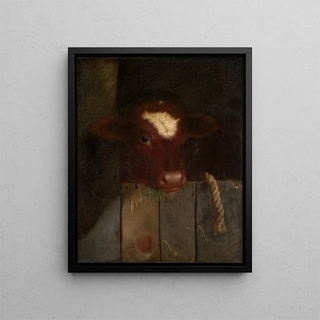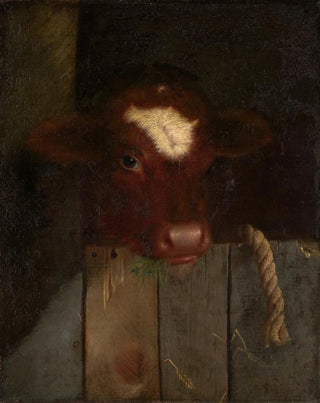Art print | The head of veal from the family cow - William Merritt Chase


View from behind

Frame (optional)
In the landscape of 19th-century American art, the art print "Reproduction La tête de veau de la vache familiale" by William Merritt Chase stands out for its delicacy and striking realism. This painting, which captures the very essence of rural life, evokes an atmosphere of tranquility and intimacy. The viewer's gaze is immediately drawn to the faithful depiction of the animal, whose presence prompts reflection on nature and everyday life. Chase, through this work, manages to transcend the simple representation of an ordinary subject to create a true ode to the beauty of domestic life.
Style and uniqueness of the art print
William Merritt Chase's style is characterized by an impressive mastery of colors and textures. In "Reproduction La tête de veau de la vache familiale," he uses a subtle palette that highlights the softness of the animal's coat and the ambient luminosity. The interplay of shadow and light gives the scene an almost tangible depth, allowing the viewer to feel the warmth of the moment. This realism, combined with an impressionist sensitivity, creates an intimate and contemplative atmosphere. Chase does not merely depict a calf; he evokes an emotion, a connection with nature that transcends time and space. The art print invites reflection on rural life and the relationships between humans and animals, while celebrating the beauty of simple things.
The artist and his influence
William Merritt Chase, born in 1849, is one of the emblematic figures of the American impressionist movement. His career, rich and varied, saw him navigate between different techniques and styles, while remaining faithful to his love for nature and daily life. Chase established himself as a master of landscape painting and still life, influencing many artists of his time. His innovative approach to light and color paved the way for a new way of perceiving art, where emotion and personal experience took precedence over strict representation of reality. Through works such as "Reproduction La tête de veau de la vache familiale," he captured the essence of his

Matte finish

View from behind

Frame (optional)
In the landscape of 19th-century American art, the art print "Reproduction La tête de veau de la vache familiale" by William Merritt Chase stands out for its delicacy and striking realism. This painting, which captures the very essence of rural life, evokes an atmosphere of tranquility and intimacy. The viewer's gaze is immediately drawn to the faithful depiction of the animal, whose presence prompts reflection on nature and everyday life. Chase, through this work, manages to transcend the simple representation of an ordinary subject to create a true ode to the beauty of domestic life.
Style and uniqueness of the art print
William Merritt Chase's style is characterized by an impressive mastery of colors and textures. In "Reproduction La tête de veau de la vache familiale," he uses a subtle palette that highlights the softness of the animal's coat and the ambient luminosity. The interplay of shadow and light gives the scene an almost tangible depth, allowing the viewer to feel the warmth of the moment. This realism, combined with an impressionist sensitivity, creates an intimate and contemplative atmosphere. Chase does not merely depict a calf; he evokes an emotion, a connection with nature that transcends time and space. The art print invites reflection on rural life and the relationships between humans and animals, while celebrating the beauty of simple things.
The artist and his influence
William Merritt Chase, born in 1849, is one of the emblematic figures of the American impressionist movement. His career, rich and varied, saw him navigate between different techniques and styles, while remaining faithful to his love for nature and daily life. Chase established himself as a master of landscape painting and still life, influencing many artists of his time. His innovative approach to light and color paved the way for a new way of perceiving art, where emotion and personal experience took precedence over strict representation of reality. Through works such as "Reproduction La tête de veau de la vache familiale," he captured the essence of his






